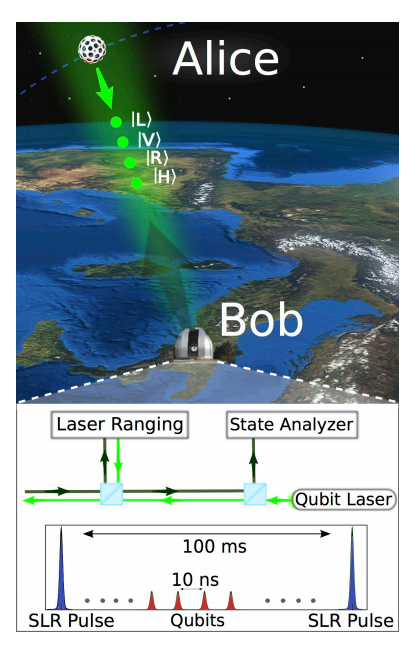The Space-Based Quantum Cryptography Race
One of the great benefits of quantum communication is the ability to send messages from one point in space to another with perfect security. Not so great is the fact that so-called quantum cryptography is limited to distances of around 100 kilometers.

That’s because over longer distances, photons tend to be absorbed by the glass in fiber-optic cables and by the atmosphere when beamed from one location to another. That causes errors that are too great for perfect privacy.
But there is a potential way around this–to send photons to an orbiting spacecraft, which then retransmits the message securely when it is over another part of the planet. That’s possible because the photons traveling straight up only have to negotiate a few tens of kilometers of the atmosphere before reaching space.
So it’s not surprising that governments all over the world are keen on exploiting space-based quantum cryptography. Indeed, last year we reported on a Chinese team that had successfully reflected individual photons off an orbiting satellite, to simulate a satellite sending photons to the ground.
The Chinese team said the demonstration was a crucial step toward space-based quantum cryptography. However, the ability to send single photons from orbit and receive them on the ground is not enough.
A key factor is the error rate in this process. If the error rate is above 11 percent, quantum cryptography does not work.
So an important unanswered question is whether the error rate is small enough.
Today, we get an answer thanks to the work of Giuseppe Vallone at the University of Padova in Italy and a few pals. These guys have bounced polarized photons off a number of different satellites and measured the error rate in the photons that return to Earth.
And they have good news. They clearly show that the error rate can be made smaller than the critical threshold.
Here’s some background. One problem for researchers hoping to test the possibility of quantum cryptography from space is that there are not yet any spacecraft capable of producing coherent photons that can carry information.
Instead, researchers have had to rely on bouncing photons off satellites designed to reflect light back to the ground. These satellites are generally used for geodetics–measuring the shape of Earth by monitoring small changes in their orbit. To do this, these craft have mirrors called corner-cube retroreflectors for laser ranging from the ground.
For quantum cryptography, it’s not enough to reflect a photon. It’s necessary to preserve its polarization as well. So these corner-cube retroreflectors must have metallic coatings rather than dielectric ones or uncoated reflectors, which do not preserve polarization.
Vallone and co chose four low Earth orbit satellites that have exactly these kinds of corner-cube retroreflectors: Jason-2, Larets, Starlettte, and Stella. For comparison, they also used the Japanese satellite Ajisai, which has uncoated corner-cube retroreflectors.
They used the facilities at the Matera Laser Ranging Observatory in southern Italy to bounce polarized photons off each of the satellites and measured the returns, with a special focus on the quantum bit error rate.
They found that the error rate for Ajisai was close to 50 percent, as expected for a device that destroys all polarization information. By contrast, the error rates for the other spacecraft were all below 11 percent.
“The quantum bit error rate was found low enough to demonstrate the feasibility of quantum information protocols such as quantum key distribution along a Space channel,” they say.
That’s a useful step forward in the race to provide perfectly secure communication channels between different parts of the planet.
This is an area that is likely to advance quickly given the obvious advantages over conventional communication channels. So it’s no wonder that researchers from China and Europe are racing to conquer this domain.
Last year, the Chinese announced plans to launch a spacecraft in 2016, called the Chinese Quantum Science Satellite. specifically designed to test these concepts. And European scientists have proposed a quantum communications experiment that could be sent to the international space station.
U.S. plans are much less clear. That may be because the work is being done behind closed doors. On the other hand, the U.S. may be dragging its feet.
Expect the former–the United States’ expertise in this area is as good as anyone’s. But don’t be surprised if the latter turns out to be true instead.
Ref: arxiv.org/abs/1406.4051 : Experimental Satellite Quantum Communications
Keep Reading
Most Popular
Large language models can do jaw-dropping things. But nobody knows exactly why.
And that's a problem. Figuring it out is one of the biggest scientific puzzles of our time and a crucial step towards controlling more powerful future models.
How scientists traced a mysterious covid case back to six toilets
When wastewater surveillance turns into a hunt for a single infected individual, the ethics get tricky.
The problem with plug-in hybrids? Their drivers.
Plug-in hybrids are often sold as a transition to EVs, but new data from Europe shows we’re still underestimating the emissions they produce.
Google DeepMind’s new generative model makes Super Mario–like games from scratch
Genie learns how to control games by watching hours and hours of video. It could help train next-gen robots too.
Stay connected
Get the latest updates from
MIT Technology Review
Discover special offers, top stories, upcoming events, and more.